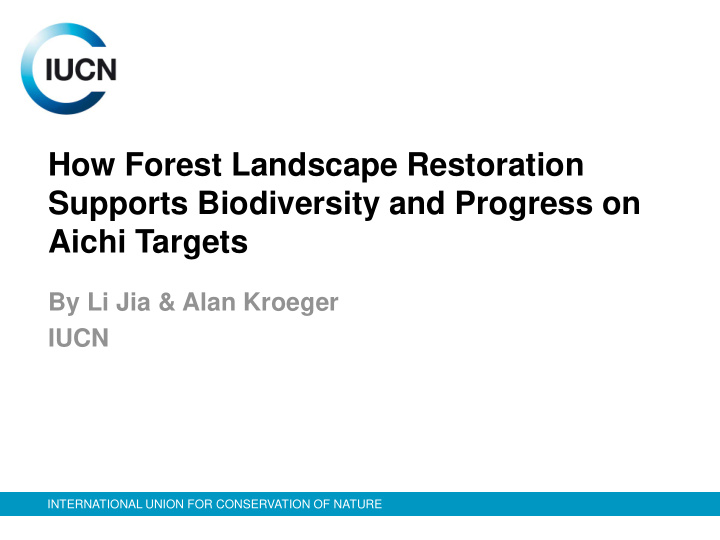



How Forest Landscape Restoration Supports Biodiversity and Progress on Aichi Targets By Li Jia & Alan Kroeger IUCN INTERNATIONAL UNION FOR CONSERVATION OF NATURE
ABOUT IUCN Commissions Secretariat Members 15,000 voluntary experts in 6 Global More than 1,300 Members Regional Programmes groups Presence worldwide from over 185 & countries: Biodiversity Programmes Conservation World Conservation Congress Nature-based Solutions Council Policy & Programme Director General & Corporate Functions 2
FOREST LANDSCAPE RESTORATION • Ongoing process of regaining ecological functionality and enhancing human well-being across deforested or degraded forest landscapes. • Restoring a whole landscape “ forward ” to meet present and future needs and to offer multiple benefits and land uses over time. 3
Because it is not just about planting trees…
…but about turning degraded lands into healthy, resilient and productive landscapes.
6
AMBITIOUS GLOBAL TARGETS EXIST Bonn Challenge 150m hectares under restoration by 2020 NY Declaration 350m hectares under restoration by 2030 Image: Flickr/CIFOR; Source: WRI 7
RESTORATION IS GAINING ATTENTION & COMMITMENT COP21 Climate Summit & COP20 8
COMMITMENTS AS OF MARCH 2016 29 commitments – 89 million hectares 9
NUMEROUS DELIVERY METHODS & PARTNERSHIPS 10
AN IMPLEMENTATION VEHICLE: THE BONN CHALLENGE 11
FOREST LANDSCAPE RESTORATION SUPPORTS THE AICHI TARGETS Ecosystems Habitat & essential loss halved services or reduced safeguarded Protected Ecosystems areas restored increased & resilience & improved enhanced 12
FLR AND BIODIVERSITY The restoration staircase. (Chazdon, 2008, Science ) 13
FLR AND BIODIVERSITY • Re-establish and increase habitat – Connectivity: reduce fragmentation & restore ecological corridors – Area: increase extent of limited habitat through reforestation – Quality: increase diversity of species and habitat structure • Resilience – climate change adaptation across landscapes and species • Indirect Benefits – Interventions for biodiversity improvement are often aimed initially at improving livelihoods and livelihood opportunities – Agroforestry, Mangroves, Woodlot creation and enhancement 14
REVIEW OF 97 COUNTRIES POLICIES, PLANS, AND MEASURES • Review of 97 countries’ FLR-relevant targets and the policies supporting them • Included submissions to the UNFCCC, CBD, UNFF, GEF, UNCC, FCPF, FIP & relevant national documents e.g. national forest and rural development programmes • Information fed into a country profile for FLR • All profiles vetted by IUCN / UN staff • Focus on finding synergy between existing development & environment projects & FLR 15
Country Profile: Republic of Korea • Identified overlaps between Korea’s National Biodiversity Strategy 2014 - 2018 & FLR, highlighting Korea’s ambition on FLR • Ecological restoration effort allows all of the vital ecosystem belts to have better connectivity – Mid and Long term Promotion Plan for Restoration Programs of Ecological Rivers – National Ecosystem Restoration Plan – Establishing restoration strategies in reference to ‘Promoting Plan of Integrated Strategy for Natural environment Restoration’ (2007) – Restoration of 50 fragmented areas in vital ecosystem belts by constructing ecological corridors • As per Korea’s 5 th National Report: – Three major ecological networks in the Korean Peninsula identified for restoration, including Baekududaegan mountain range, DMZ, coastal/island areas 16
Country Profile: Malaysia 5 th National Report • National Physical Plan 2: optimize utilization of land and natural resources for sustainable development and biodiversity conservation • Central Forest Spine Master Plan: re-establishing, maintaining and restoring forest connectivity • Heart of Borneo (Strategic Action Plan 2008-2012) – Sabah: Reforestation and restoration efforts aimed at restoring forest functionality over 150,000 hectares of the most degraded areas 17
Country Profile: Nepal NBSAP (2014) • Strategic Approaches: – Promotion of landscape conservation and climate resilient approaches for ecosystems and biodiversity management • Thematic Strategies and Priorities for Actions – Improving forest productivity, biodiversity conservation and climate change resilience of forests through sustainable management. At least 50 percent of the production forests to be brought under sustainable management by 2020. • 5 th National Report: strategies for meeting Aichi targets – Target 14 & 15: afforestation and reforestation programs – Target 15: identifying, conserving and promoting ecological corridors and landscape connectivity to enable movement of species in the context of climate change 18
Country Profile: Philippines • Assessed the 5th National Report to the CBD – “ Protect and conserve existing natural habitats and pursue restoration of the functionality of degraded habitats ” – Priority Strategy 1 – “ Implement habitat rehabilitation programs and strengthen collaboration among relevant agencies and stakeholders on land and water use, resource extraction, ecosystem restoration, law enforcement and sustainable livelihoods especially for vulnerable sectors such as indigenous peoples, women and youth. ” – Priority Strategy 3 • Targets specific to FLR include: • Reforestation of 1.5 billion trees (2011-2016) – Target 5 • Restoration and maintenance of healthy mangroves to combat strong typhoons and storm surges – Target 15 19
Country Profile: Singapore • Reviewed 4 th National Report (2010) & National Biodiversity Strategy Action Plan (NBSAP) 2009 • Strategy is to incorporate the conservation of natural areas with recreational public parks ( planting of 1.3 million trees and restoration of mangroves) • Focus is on: - Protecting key indigenous ecosystems - Implement species conservation & recovery programmes - Rehabilitate degraded areas - Extend green corridors to counter fragmentation 20
CONCLUSION • FLR supports CBD NBSAPs & multiple Aichi Targets • It goes beyond site-level conservation & focuses on creating or enhancing landscape connectivity • It allows countries to combat habitat fragmentation • It supports the conservation of species that require intact forest landscapes • Overall, restoring ecosystem resilience, functionality, and productivity, and reducing pressure on intact forest landscapes 21
Thank you! For more information, contact Li Jia Jia.li@iucn.org Forest Landscape Restoration Coordinator, Asia IUCN, International Union for Conservation of Nature 22
Recommend
More recommend